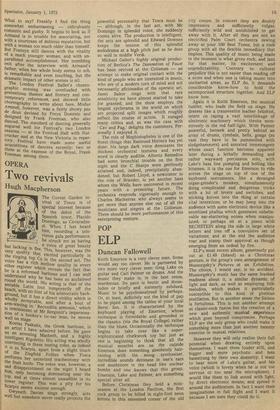BALLET
Period piece
Robin Young
Everyone who takes the slightest interest has strong ideas about what the Royal Ballet should, or should not, be doing. I, for one, am glad that they took the opportunity of the coincidence of Sir Arthur Bliss's eightieth birthday with Sir Robert Helpmann's availability in this country to revive Dams Ninette de Valois's Checkmate. The ho!' ours accorded those associated with the ballet since it was created in 1937 signifY that it has some measure of importance the history of English dance drama. My first reaction is to say: "They don't make ballets like that any more." Check' mate, with Bliss's emphatic score, de Valois's tightly organised choreographY, and McKnight Kauffer's heavily symbolic costumes, is very much of a piece — 8 period piece, no doubt, but fashioned by true craftsmen, and destined, I am sure, to stand the test of time. In its best moment5 this symbolic chess match between Love and Death is powerfully reminiscent uf Eisenstein's Ivan the Terrible and Berg' man's Seventh Seal, and in the same class.
Nureyev's looks were not flattered bY his Red Knight's headpiece, and he was dancing a little under par, but he made a convincing display of valour lacking in die cretion. Monica Mason, as the Black Queer who treacherously slays him, danced right up to her billing as "the most powerful piece on the board." She can be reallY wicked, and dances this role with an eye flashing venom which puts one's soul ice. And at the end we have the Red King, doddering, defiant, cunning and doomed Helpmann was a legend in the part whe he was still a young man: I can believe he is right when he says that he has never, played it better than now.
After this, and the Opera House's custor0; arily lengthy interval, we had Robbins s Afternoon of a Faun. It is astonishing t,e think that when first presented in Amery ca it was seen as a satire on balletitself If this is a satire on ballet, you might call Conservative party political broadcaste satires on Edward Heath. Certainly there is humour there for those who seek it, bill to the converted the piece will seem whollY admirable and inoffensive.
In place of the mythical faun we have; in a studio, a dancer of almost mythical beauty — Anthony Dowell (who else?). fle admires himself in a mirror supposed ti/, be where the audience is. He is interruptea, by a danseuse — Antoinette Sibley, :al course. She admires herself. They adMire themselves. He places one tentatiVe: delicate kiss on her cheek. She, admiring]) and wonderingly, withdraws. He returns te rest. It is charming, rather lovely to lel at, but much too slight to be surrounde, (as here) by a full fifty-five minutes °3 interval time. We ended With Marguerite and Armand' meaning of course Fonteyn and Nureyestl What to say? Frankly I find the thing somewhat embarrassing — ridiculously romantic and gushy. It begins to look as if Armand is in trouble for associating, not with a courtesan of dubious reputation, but with a woman too much older than himself. But Fonteyn still dances with the vitality of a much younger woman, and with unparalleled accomplishment. Her trembling exit after the interview with Armand's father, when her whole body seems to sob, is remarkable and even touching, but the dramatic impact of other scenes is nil. The London Festival Ballet's choreographic evening was overloaded with pretentious themes and literary and contemporary references, and showed little choreography to write about here. Modus Atnandi, however, was a fairly showy pas de deu.x devised by Freya Dominic and designed by Frank Freeman, who also danced. The standard of dancing generally augured well for Festival's two London seasons — at the Festival Hall with Nutcracker and at the New Victoria in repertory. Festival have made some useful acquisitions of dancers recently: two or three at the expense of the Royal, Frank Freeman among them.















































 Previous page
Previous page